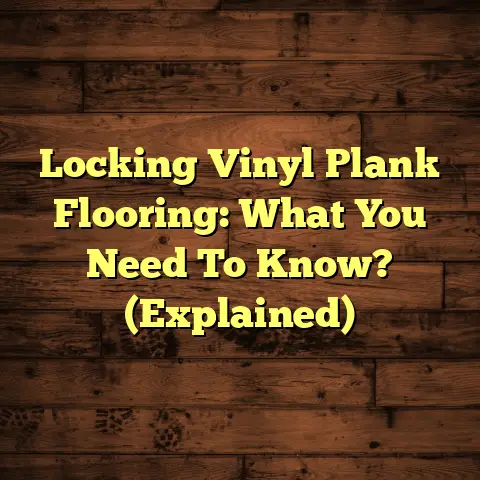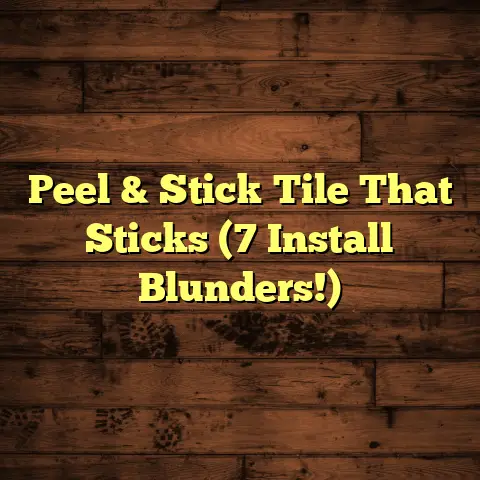Can You Rent A Concrete Grinder? (Explained)
Why did the concrete grinder break up with the floor?
Because it found someone more level!
Alright, let’s get into it! I’ve spent years in the flooring business, and I can tell you that concrete grinders are truly game changers. Whether you’re prepping a floor for a new surface or polishing existing concrete, grinding is where it’s at. But here’s a common question: can you rent a concrete grinder? Spoiler alert: yes, you can!
Why Rent a Concrete Grinder?
Renting a concrete grinder can be a smart choice. For one, not everyone needs to own this heavy-duty equipment. If you’re like me and often take on projects requiring specific tools only occasionally, renting makes perfect sense. It saves on storage space, maintenance, and upfront costs.
But how do you go about renting one? Here’s what I learned through my experiences:
Finding the Right Rental Shop
I usually start by checking out local hardware stores or specialized equipment rental shops. I’ve found that larger chains often have a more extensive selection and may offer better prices than smaller shops. When I was working on a residential project in Dhaka, I found a fantastic rental shop that provided grinders of various sizes.
When approaching these shops, don’t hesitate to ask questions. What type of grinder will best suit your needs? Most places will have knowledgeable staff who can guide you based on your project size and type.
Understanding the Costs
Rental costs can vary based on location and equipment type. In my experience, I’ve seen rates from around $50 to $150 per day. For instance, when I rented a concrete floor grinder for a week-long project, it set me back about $300. Not too shabby when you consider the alternative of purchasing one for thousands.
Using tools like FloorTally has also helped me keep track of these costs. It allows me to input various expenses associated with the project, including rental fees. Having everything in one place helps me stay organized and ensures I don’t miss any hidden costs.
Choosing the Right Grinder
There are several types of concrete grinders: walk-behind models, handheld grinders, and even planetary grinders. My first-ever experience with a grinder was with a handheld model, and let me tell you, it was quite the workout!
Walk-Behind Grinders:
These are great for larger areas. They’re efficient and can cover more ground in less time. For instance, during a commercial project at a local gym, I used a walk-behind grinder to tackle an enormous floor area. It took about two days to get it polished just right.
Handheld Grinders:
These are fantastic for edges or smaller spaces. However, they require more effort and can be tiring if you’re working for extended periods. I remember one job at a café where I needed to grind down some tricky corners—my arms were definitely feeling it by the end of the day!
Planetary Grinders:
These are best for those looking to achieve that high-gloss finish. They might be pricier to rent but can save time and effort in the long run.
Setting Up for Success
Once you’ve rented your grinder, it’s time to get to work! Here’s how I usually prepare:
- Read the Manual:
I know it sounds boring, but understanding how your specific grinder operates is crucial. Some models have unique features that can make your job easier. - Wear Protective Gear:
Safety first! Invest in some quality safety glasses, dust masks, and ear protection. You’ll thank yourself later—trust me. - Clear the Area:
Before starting, make sure the workspace is free of debris and obstacles. This will help avoid any accidents and make your grinding smoother. - Plan Your Path:
I like to map out my grinding path beforehand; it helps to work efficiently without missing spots.
Challenges I’ve Faced
Of course, not everything goes smoothly. During one project at an old warehouse, I ran into some unexpected issues with the flooring beneath layers of paint and adhesive. The initial grinding was going well until I hit some thick adhesive that just wouldn’t budge!
I quickly realized that I needed a different attachment for my grinder—one designed specifically for tougher materials. Thankfully, the rental shop had what I needed.
Maintenance and Care
After using the grinder, cleaning it is essential before returning it. I usually wipe down the machine and check for any wear on the diamond blades or attachments. If they’re worn out, you may need to replace them before your next rental—another added cost if you’re not careful!
Tips for a Successful Grind
Here are some practical tips based on my experiences:
- Start with Coarse Grit: Begin with a rougher grit to remove any imperfections and then gradually transition to finer grits for polishing.
- Keep Moving: Don’t stay in one spot too long; keep the grinder moving to prevent gouges in the concrete.
- Check Your Progress: Regularly stop to check your work; this will help you catch any problems early.
- Use Water Wisely: If you’re using a wet grinder, be mindful of water usage to avoid making your workspace too slippery.
Understanding Concrete Grinding
Concrete grinding is a process that involves using specialized equipment to smooth out rough surfaces, remove imperfections, or prepare for further treatments like sealing or polishing. As someone who has worked on numerous projects involving concrete floors, I can tell you that understanding this process is key to achieving the desired outcome.
The Equipment Behind Grinding
When I first started out, I was amazed at how technology has evolved in flooring tools. The modern concrete grinder typically consists of:
- Diamond Grinding Pads: These are essential for effectively grinding down concrete surfaces. Different grits serve various purposes, from heavy grinding to fine polishing.
- Motor Power: The horsepower of the grinder affects its efficiency. A more powerful motor means faster work.
- Dust Control Features: Many grinders come equipped with dust shrouds that connect to vacuums to minimize mess—a huge plus in keeping my work environment clean.
The Grinding Process
The grinding process generally involves these steps:
- Preparation: This is where you assess the floor condition and decide on the appropriate grit.
- Initial Grind: Using coarse grit pads helps remove major imperfections and prepares the surface for finer grits.
- Intermediate Grind: Transitioning to medium grits allows for more refinement of the surface texture.
- Final Polish: Using fine grit pads brings out that glossy finish many clients love.
During each step, communication with clients is essential; they need to understand what’s happening and how it affects their flooring investment.
Success Stories
I recall one memorable project where I worked on an outdoor patio for a client who wanted a sleek finish that would withstand the elements while looking stunning during family gatherings.
After assessing the existing concrete, we decided on a two-day grind-and-polish approach. Day one involved heavy grinding with coarse pads to remove imperfections and prepare the surface. By day two, we moved on to polishing with finer pads that brought out a beautiful sheen.
The client was thrilled with the results! It was rewarding to see their vision come to life while knowing I played a part in creating their dream space.
Lessons Learned from Challenges
However, not every project goes as planned. I once tackled an older building’s basement floor that had years of neglect and damaging substances spilled over time. The initial grind revealed unforeseen cracks and unevenness—things I couldn’t have predicted just by looking at it from above.
This required additional steps: I had to use a concrete resurfacing product after grinding down the floor before applying any finish. While it took longer than expected, my commitment to quality paid off when the client saw how much better their basement looked afterward.
Comparing Grinding Options
When deciding between renting versus buying a concrete grinder, consider these factors based on my experiences:
- Frequency of Use: If you only need it occasionally, renting is likely more cost-effective.
- Storage Space: Grinders take up space; if you lack room in your workshop or garage, renting is preferable.
- Maintenance Costs: Owning machinery means dealing with wear and tear over time—renting typically alleviates this burden.
- Project Type: Some projects may require specialized equipment; renting gives you access to various models without committing to purchase.
Practical Guidelines for Using Concrete Grinders
Let’s talk specifics! Here are some handy guidelines and tips I’ve compiled over my years of experience:
Pre-Grind Preparation
- Inspect the Floor: Check for cracks, stains, or other issues that may require special attention.
- Choose Your Equipment Wisely: Based on your assessment, select a grinder suited for your project’s needs.
- Gather Your Supplies: Make sure you have all necessary pads, water (if applicable), protective gear, and cleaning supplies ready.
Operating the Grinder
- Start Slow: When beginning your grind, take your time getting used to the equipment.
- Maintain Consistent Pressure: Applying too much pressure can damage both the grinder and your surface.
- Take Breaks: Grinding can be physically demanding. Ensure you take breaks to avoid fatigue affecting your performance.
Post-Grind Cleanup
After completing your grind, here’s what you should do:
- Thoroughly Clean the Area: Clear away dust and debris before moving on to any finishing touches.
- Inspect Your Work: Check for any areas that might need additional attention or touch-ups.
- Return Equipment Promptly: When renting, ensure everything is returned clean and in good condition.
By following these guidelines, you’ll set yourself up for success whether you’re working on residential or commercial projects.
Additional Tips from My Experience
- Consider Hiring Help: If you’re unsure about handling it alone or if it’s a large job, hiring help can save time and ensure quality results.
- Utilize Online Resources: There are countless tutorials and forums where seasoned contractors share insights about specific techniques or challenges.
- Network with Other Contractors: Building relationships with other professionals can open doors to advice or even potential partnerships down the line.
Conclusion
Renting a concrete grinder can be an effective solution for flooring projects without breaking the bank. With careful planning, proper equipment choice, and attention to detail, you’ll be able to tackle any grinding job with confidence.
In my journey as a flooring contractor, I’ve learned that preparation is key. If you take the time to understand your grinder and set up properly, you’ll save time and avoid potential headaches along the way.
So next time you’re faced with a concrete flooring challenge, consider renting that grinder instead of buying—your wallet (and your back) will thank you!





